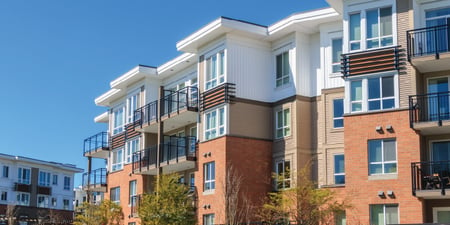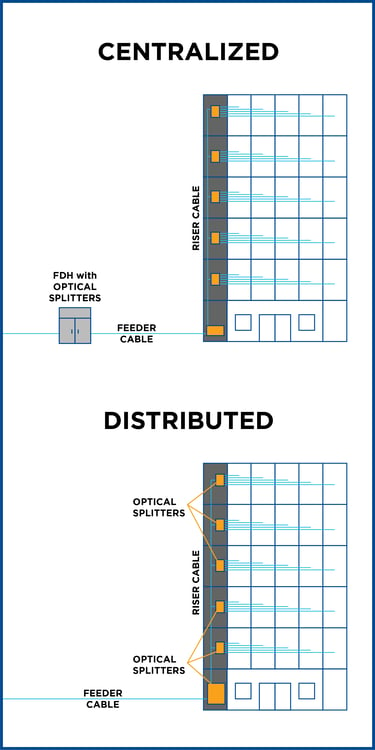 When service providers are planning a fiber optic installation at a multi-dwelling or multi-tenant unit (MDU or MTU), there are several suitable solutions depending on factors such as the number of buildings or required fiber ports.
When service providers are planning a fiber optic installation at a multi-dwelling or multi-tenant unit (MDU or MTU), there are several suitable solutions depending on factors such as the number of buildings or required fiber ports.
To determine the solution that is best for your fiber installation, we recommend following a step-by-step process to choose products that match your needs. To make this easier, here’s an eight-step guide with essential questions to ask before finalizing a bill of materials.
Step 1- How Many Buildings Are There and What's the Construction Type?
The first set of questions to ask: are you dealing with one building, or multiple buildings, and are the buildings pre-existing or new construction? Let’s dive into how the answers affect deployment recommendations.
If there is only one, new construction building to be considered, deploying a centralized split is recommended. If multiple buildings are involved in the installation, the deployment plan should include placing splitters in multiple locations to deliver fiber to the different buildings.
The type of construction you’re working with also needs to be considered. Are you dealing with pre-existing buildings (brownfield) or new construction (greenfield)? We’ll go into more detail about what all of this means in Step 6, so keep reading!
Step 2- How Many Total Units Require a Fiber Port?
Next, you’ll need to determine how many fiber ports you need at your hub. Fiber ports are the connection points to deliver service at the subscriber destination. In some cases, one fiber port can serve multiple units, and in other cases, each unit needs its own dedicated port. For example, in an MDU construction, you can have one fiber port providing service to eight units, or you can have eight ports for eight units. One port per unit ensures the highest level of service is available for each end-user but can be more expensive to install and can result in unused capacity if customer take rate is low.
Once you decide the total number of ports needed, you’ll be able to determine which size hub you’ll need at the start of the split.
Step 3- How Many Extra Ports to Add for Future-Proofing?
When determining your fiber port density for the hub at the start of the split, the rule of thumb is to always add at least 20 percent more ports than you need. For example, if you have a 100-unit building with one port per unit, best practice is to design the port density to be 120 or more ports. This allows for easier adjustment to use spare ports to bypass unusable ports in the future.
In addition, service providers can generate more revenue from subscribers with those extra ports. The additional ports can act as a direct circuit that doesn’t go through a splitter. These ports can offer a higher-speed connection to consumers who are willing to pay more.
Step 4- Which Connectors Do You Need?
It’s important to determine in advance what type of connectors you will need for the fiber installation. There are multiple options to choose from, including SC versus LC and APC versus UPC. If the service provider you work for doesn’t have a preference, we recommend an APC (green) connector because it’s a universal connector type and works with every fiber PON. For additional information on APC and UPC connectors, you can read more in our blog discussing the difference between both connector types.
Step 5- What is Your Desired Split Ratio?
Your desired split ratio will dictate how much power is at the end port. The lower the ratio (1:2 or 1:4), the higher the power you’ll see at the end port. The higher the ratio, the lower the power. We recommend a 1:32 split ratio for an APC connection. A 1:32 split is also a common, industry-standard ratio that’s easy to configure. One splitter, or a combination of cascaded splitters, can be used to achieve a 1:32 split ratio.
Step 6- Can You Deploy a Centralized Split?
 As mentioned in Step 1, you’ll need to decide whether to deploy a centralized or distributed split. In a centralized split, you’ll place one fiber distribution hub on the property and run larger fiber count cables to terminals on each floor or to each subscriber. A distributed split uses multiple splitter enclosures throughout the network path that utilize lower fiber count cables to deliver fiber to the subscriber units.
As mentioned in Step 1, you’ll need to decide whether to deploy a centralized or distributed split. In a centralized split, you’ll place one fiber distribution hub on the property and run larger fiber count cables to terminals on each floor or to each subscriber. A distributed split uses multiple splitter enclosures throughout the network path that utilize lower fiber count cables to deliver fiber to the subscriber units.
If the building is greenfield, or if you have a clear pathway for installing individual fibers throughout the walls, plan for a split in a centralized location outside the building. If you are dealing with a brownfield building that doesn’t have easily accessible pathways, your network will require one fiber cable routed inside or outside walls and multiple splitters throughout the building, which is considered a distributed split. The building type is a true indicator of how the installation process will proceed and will help determine the necessary products you’ll need to move forward.
Step 7- Do You Prefer Pre-Terminated or Splicing Solutions?
There are two options when it comes to deploying fiber cable: pre-terminated cable assemblies or bulk cable for spliced terminations.
Pre-terminated solutions have connectors on both ends of the fiber cable, and once you route the cable from Point A to Point B, all an installer needs to do is clean the connector end and plug it into a port. A pre-terminated cable is easier to install, however you’ll need to account for any slack in the destination enclosure, and ensure you install a cable assembly that’s closest to the length you will need in the cable run.
Using bulk fiber cable is less expensive in material costs, but more expensive to install and splice. Splicing is a method of joining two fiber cables by fusing the glass strands together. Splicing utilizes specialized equipment and requires highly skilled technicians to complete the job. With splicing, installers don’t need to worry about planning for slack storage because there is minimal slack to deal with.
To learn more about the advantages and disadvantages of pre-terminated cable assemblies versus splicing bulk cable, visit our popular blog on the topic.
Step 8- Do You Have Horizontal Fiber Requirements?
There are multiple parts to every fiber deployment. First the service provider must bring the fiber to the outdoor hub and into building. Next is to deliver the fiber vertically to each floor – those two parts are covered in Steps 1 to 7 of this blog. The last part is the horizontal deployment, bringing the fiber to an individual apartment unit, hotel room, office space, or wherever the end port is located.
These horizontal requirements are detailed enough for a blog all its own, and that's why we published a Part Two of this blog discussing just that. Here are a few questions we ask in the blog that you'll want to consider:
- Do you have access to the conduit pathways to run cable behind the walls?
- Will you use pre-terminated or bulk cable, or a combination of both?
- What type of wall plates do you require?
Wrapping It Up
As you’re working with suppliers to purchase products for your fiber installation, always remember to consider solutions that can be customizable based on your needs. Not all products are best for your project, so working with a supplier who can help you organize your network build and provide you with every product needed from the central office to the subscriber’s end port is the key to a successful and cost-effective deployment.




